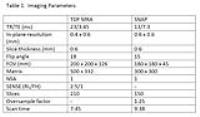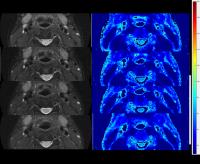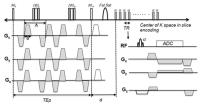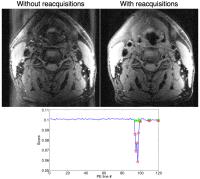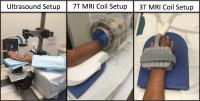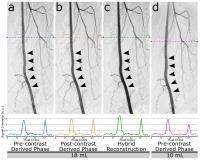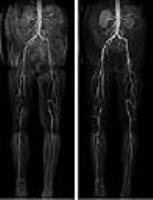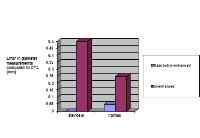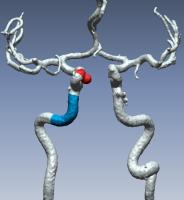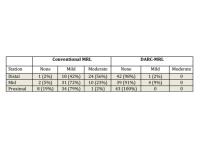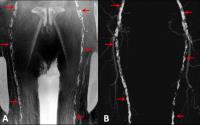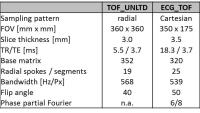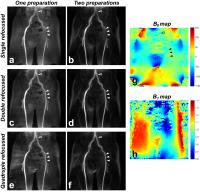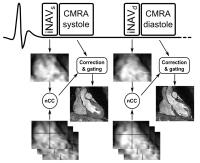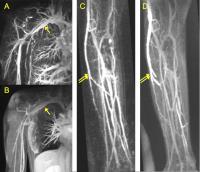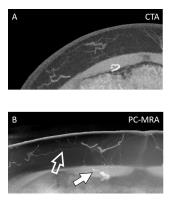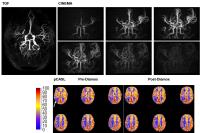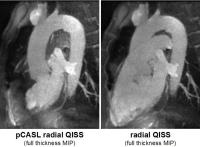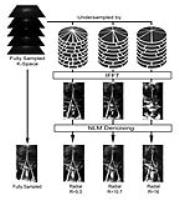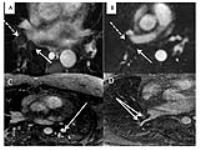|
Exhibition Hall 10:45 - 11:45 |
|
|
|
Computer # |
|
2696.
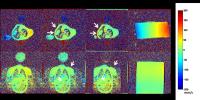 |
73 |
Performance of Self-Calibrated Phase Contrast Correction in
Pediatric and Congenital Cardiovascular MRI 
Ana Beatriz Solana1, Erin A. Paul2, Ek
Tsoon Tan3, Amee M. Shah2, Wyman W.
Lai2, Christopher J. Hardy3, and
Anjali Chelliah2
1GE Global Research, Garching bei Muenchen,
Germany, 2Dept
of Pediatrics, New York-Presbyterian Morgan Stanley
Children's Hospital of New York, New York, NY, United
States, 3GE
Global Research, Niskayuna, NY, United States
Phase contrast (PC) MR flow measurements are affected by
multiple sources of error, including background phase
offsets. The gold-standard approach to correct these
offsets involves repeating PC measurements on a static
phantom, prolonging each CMR study and impeding exam
workflow. Here, we compared the performance of a
self-calibrated correction to static-phantom corrected PC
data obtained from a pediatric and congenital heart disease
population. Self-calibrated correction results showed strong
agreement with phantom-corrected data for all vessel types
and differed from static-phantom correction by a mean
difference in Qp/Qs values of only 0.069.
|
 |
2697.
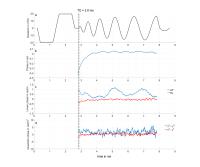 |
74 |
Analysis and correction of eddy current induced artifacts in
spiral phase contrast MRI using Point RESolved Spectroscopy 
Rene Bastkowski1, Kilian Weiss1,2,
David Maintz1, and Daniel Giese1
1Department of Radiology, University Hospital of
Cologne, Cologne, Germany, 2Philips
Healthcare, Hamburg, Germany
A novel method based on single-voxel-spectroscopy (PRESS)
for the analysis and correction of eddy-current induced
artefacts in spiral phase-contrast MRI is presented. It is
demonstrated, that 0th and 1st order corrections result in
residual background offsets of less than 0.5cm/s, inherently
correcting for geometrical misalignments between flow
acquisitions as well as 2nd order spatial phase offsets. The
method does not require special hardware and can be applied
as a pre-scan.
|
 |
2698.
 |
75 |
ktv-ARC reconstruction for 4D flow MRI using correlations
between velocity encodings 
Fatih Suleyman Hafalir1,2, Ana Beatriz Solana2,
Peng Lai3, Malek Makki4, Anja C.S.
Brau5, Axel Haase1, and Martin A.
Janich2
1Technischen Universität München, Munich,
Germany, 2GE
Global Research, Munich, Germany, 3GE
Healthcare, Menlo Park, CA, United States, 4MRI
Research Center, University Children Hospital, Zurich,
Switzerland, 5GE
Healthcare, Munich, Germany
4D flow MRI is a powerful tool for visualization and
quantification of blood flow. Repeated acquisition of 4
echoes with different velocity encoding is needed to measure
flow in 3D. In this study, we propose a new ktv-ARC
reconstruction by incorporating correlations between
velocity encoded echoes (v) to the spatiotemporal
correlations (kt). The error behavior of the method was
analyzed on retrospectively undersampled in vivo cardiac
data and resulted in more accurate velocity images with
ktv-ARC compared to kt-ARC.
|
|
2699.
 |
76 |
Accuracy of relative pressure measurements from 3D PC-MR data
using realistic aortic coarctation phantoms 
Jesús Urbina1,2, Julio Sotelo1,3,
Cristian Montalba1, Felipe Valenzuela1,3,
Cristián Tejos1,3, Pablo Irarrázaval1,3,
Marcelo Andia1,4, Israel Valverde5,6,
and Sergio Uribe1,4
1Biomedical Imaging Center, Pontificia
Universidad Católica de Chile, Santiago, Chile, 2School
of Medicine, Pontificia Universidad Católica de Chile,
Santiago, Chile, 3Electrical
Engineering Department, Pontificia Universidad Católica de
Chile, Santiago, Chile, 4Radiology
Department, Pontificia Universidad Católica de Chile,
Santiago, Chile, 5Pediatric
Cardiology Unit, Hospital Virgen del Rocio, Seville, Spain, 6Institute
of Biomedicine of Seville, Universidad de Sevilla, Seville,
Spain
The aim of this work was to evaluate the accuracy of
relative pressures obtained from 3D PC-MRI in a realistic
aortic phantom with different grades of aortic coarctations
at rest and stress conditions. We also evaluated the
accuracy of the relative pressures when subjected to
different aortic segmentation and spatial resolutions. The
accuracy of the 3D PC-MRI is excellent compared with
catheterization values with mild to moderate AoCo at rest
and stress conditions. Also, relative pressures were in
excellent accuracy with catheterization values when the
aortic segmentation only included laminar flow and with
higher spatial resolution at rest and stress conditions.
However, its accuracy decreases for severe AoCo cases.
|
|
2700.
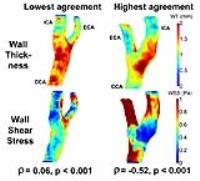 |
77 |
4D flow MRI-derived Wall Shear Stress Correlates with Vessel
Wall Thickness: Atlases of the Carotid Bifurcation - Permission Withheld
Pim van Ooij1, Merih Cibis2, Wouter V.
Potters1, Oscar H Franco3, Meike
Vernooij4, Aad van der Lugt4, Frank J
Gijsen2, Jolanda J Wentzel2, and Aart
J Nederveen1
1Radiology, Academic Medical Center, Amsterdam,
Netherlands, 2Biomedical
Engineering, Erasmus MC, Rotterdam, Netherlands, 3Epidemiology,
Erasmus MC, Rotterdam, Netherlands, 4Radiology,
Erasmus MC, Rotterdam, Netherlands
The purpose of this study is to investigate if, already in
early disease, a correlation exists between wall thickness
(WT) and wall shear stress (WSS) in the carotid bifurcation.
Eleven subjects with plaques in the left carotid arteries
underwent 3D-flow-MRI and proton-density-weighted-EPI for
WSS and WT quantification, respectively. Relationships
between WT and WSS were investigated on an individual basis
and using cohort-averaged maps (atlases). Spearman’s ρ
averaged over all subjects was -0.28, which was
significantly different from 0 (p<0.001). For the atlases, ρ
was -0.66 (p<0.001). The atlas approach facilitates more
statistical power to show that wall thickening occurs in low
WSS regions.
|
|
2701.
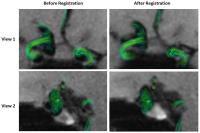 |
78 |
Flow and Structure with Simultaneous Visualization of Registered
4D Flow and Black Blood MRI 
Dahan Kim1,2, Carson Hoffman1, Oliver
Wieben1,3, and Kevin M. Johnson1
1Department of Medical Physics, University of
Wisconsin, Madison, WI, United States, 2Department
of Physics, University of Wisconsin, Madison, WI, United
States, 3Department
of Radiology, University of Wisconsin, Madison, WI, United
States
In this work, we examined the feasibility of registering
4D-flow MRI scans with different scan sequences, and
demonstrate how the incorporation of complementary,
registered data can enhance characterization of hemodynamic
information. Black blood (BB) and 4D-flow magnitude images
demonstrated excellent registration between the pre- and
post-rotation data sets, with high values of correlation and
good overlap of the vessels between head rotation. Joint
visualization of aneurysm 4D flow and BB shows accurate
lesion depiction only after registration and is a promising
technique for the comprehensive evaluation of vascular
pathology.
|
|
2702.
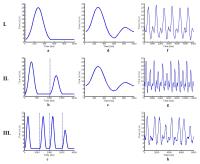 |
79 |
A Validation Study of Real-time Phase Contrast MRI with Low-Rank
Modeling 
Aiqi Sun1, Bo Zhao2, Yunduo Li1,
Qiong He1, Zechen Zhou1, Shuo Chen1,
Rui Li1, and Chun Yuan1,3
1Center for Biomedical Imaging Research,
Department of Biomedical Engineering, School of Medicine,
Tsinghua Universiy, Beijing, China, People's Republic of, 2Martinos
Center for Biomedical Imaging, Harvard Medical School,
Chalestown, MA, United States, 3Department
of Radiology, University of Washington, Seattle, WA, United
States
Conventional phase-contrast (PC) MRI method relies on
ECG-synchronized cine acquisition to acquire data over
multiple cardiac cycles. The underlying spatiotemporal
averaging limits this method to studying pathological
irregularities. Real-time PC-MRI is a promising approach to
overcome these limitations. Although several techniques have
been developed to real-time PC-MRI, few have been fully
validated due to the difficulty of acquiring a reference
data set as gold standard. This study aims at validating the
accuracy of a novel real-time PC-MRI technique through both
flow phantom experiments and in vivo experiments.
|
|
2703.
 |
80 |
Validation of compressed sensing accelerated 2D flow MRI in the
common carotid arteries 
Eva S. Peper1, Wouter V. Potters1,
Bram F. Coolen1, Henk A. Marquering1,
Gustav J. Strijkers1, Pim van Ooij1,
and Aart J. Nederveen1
1Radiology, Academic Medical Center (AMC),
Amsterdam, Netherlands
Flow MRI of the carotid arteries has emerged as an important
imaging field during the last decade and has been shown
valuable for the assessment of hemodynamics in the context
of atherosclerosis. In this study a 2D flow acquisition was
accelerated using random undersampling and compressed
sensing reconstruction. For validation of the reconstructed
flow a phantom experiment was performed at different
acceleration factors followed by an in vivo scan of the
carotid arteries.
|
|
2704.
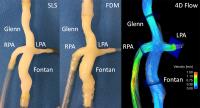 |
81 |
Effects of 3D-printing technology on flow measurements in
patient-specific models of total cavo-pulmonary connection 
Christopher J Francois1, Zachary Borden1,
Sylvana Garcia-Rodriguez1, Jon Wrobel1,
and Alejandro Roldan-Alzate1
1Radiology, University of Wisconsin - Madison,
Madison, WI, United States
This study investigated the effects of 3D printing
technology on flow rates in patient-specific total
cavo-pulmonary connection models. 4D flow MRI was used to
quantify flow through the Fontan, Glenn, left pulmonary
artery and right pulmonary artery in three models at four
different flow rates. No statistically significant
differences in flow in any of the regions of interest were
observed.
|
|
2705.
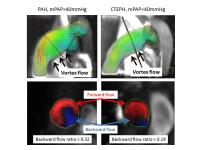 |
82 |
4D flow MR imaging for differentiation of pulmonary arterial
hemodynamics in pre-capillary pulmonary hypertension 
Hideki Ota1, Koichiro Sugimura2,
Haruka Sato2, Yuta Urushibata3,
Yoshiaki Komori3, Hiroaki Shimokawa2,
and Kei Takase1
1Diagnostic Radiology, Tohoku University
Hosipital, Sendai, Japan, 2Cardiovascular
Medicine, Tohoku University Hosipital, Sendai, Japan, 3Research&Collaborations,
Siemens Japan KK, Tokyo, Japan
Etiologies of pre-capillary pulmonary hypertension may be
associated with pulmonary arterial hemodynamics. This study
included 64 patients (pulmonary arterial hypertension [PAH],
25, chronic thromboembolic pulmonary hypertension [CTEPH],
39) who underwent 4D flow and cardiac MR imaging. Backward
flow ratio and forward flow eccentricity in the pulmonary
trunk as assessed by 4D flow MR and several cardiac MR
parameters were different between two diseases. After
controlling for age and mean pulmonary arterial pressure,
backward flow ratio was the strongest differentiator of PAH
from CTEPH. 4D flow has a potential to visualize different
pulmonary arterial hemodynamics according to etiologies in
pulmonary hypertension.
|
|
2706.
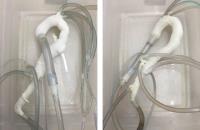 |
83 |
4D flow MRI Improves Computational Fluid Dynamics Analysis of
Aortic Dissection 
Sylvana García-Rodríguez1, Jon Wrobel1,
Alejandro Roldán-Alzate1,2, and Christopher J.
François1
1Radiology, University of Wisconsin-Madison,
Madison, WI, United States, 2Mechanical
Engineering, University of Wisconsin-Madison, Madison, WI,
United States
The effects of MRI-derived three-directional velocity
profiles implemented at the inlet of aortic dissection (AD)
computational fluid dynamics (CFD) simulations were
investigated. Two AD models were generated from in vivo MRA
data using 3D printing. In vitro 4D Flow MRI was performed
on the AD phantoms at two flow rates. Normal and
multidirectional blood flow vectors at the AD inlet was
measured from 4D Flow MRI data and used in CFD simulations.
Significant differences were found in pressure distribution
in response to inlet boundary condition definitions. Peak
velocity and wall shear stress were also affected by inlet
condition definition.
|
|
2707.
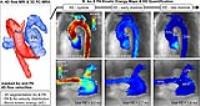 |
84 |
4D flow MRI derived energetic biomarkers are abnormal in
repaired tetralogy of Fallot patients and may predict
deteriorating hemodynamics 
Joshua Daniel Robinson1,2, Cynthia K Rigsby3,4,
Michael Rose3, Susanne Schnell4, Alex
J Barker4, and Michael Markl4,5
1Pediatric Cardiology, Ann & Robert H Lurie
Children's Hospital, Chicago, IL, United States, 2Pediatrics,
Northwestern University Feinberg School of Medicine,
Chicago, IL, United States, 3Medical
Imaging, Ann & Robert H Lurie Children's Hospital, Chicago,
IL, United States, 4Radiology,
Northwestern University Feinberg School of Medicine,
Chicago, IL, United States, 5McCormick
School of Engineering, Northwestern University, Evanston,
IL, United States
Tetralogy of Fallot (TOF) is the most common form of
cyanotic heart disease. As life expectancy continues to
increase, MRI plays a central role in evaluation for
post-operative complications and reintervention. Current
assessment is based on simplified parameters that measure
late expression of underlying physiologic changes, with poor
outcome prediction. In this study, we explore quantitative
4D flow metrics which may be important measures of
hemodynamic efficiency. We found that energetic metrics are
abnormal in TOF compared to healthy controls. While these
metrics correlated only modestly with routine measurements
of ventricular efficiency, they may represent earlier
biomarkers of disease progression.
|
|
2708.
 |
85 |
Highly Accelerated 4D Flow MRI with CIRcular Cartesian
UnderSampling (CIRCUS) in Patients with Intracranial Aneurysms - Permission Withheld
Jing Liu1, Yan Wang1, Farshid Faraji1,
Sarah Kefayati1, Henrik Haraldsson1,
and David Saloner1,2
1University of California San Francisco, San
Francisco, CA, United States, 2VA
Medical Center, San Francisco, CA, United States
A highly accelerated 4D flow MRI method with a high
tempospatial resolution has been validated in healthy
volunteers by comparing to the conventional method. The
proposed method been demonstrated to be very promising for
imaging the patients with intracranial aneurysms, by
achieving an isotropic resolution of 1.3mm and a temporal
resolution of 26ms within a 5-minute scan time (R=12).
|
|
2709.
 |
86 |
Non-Contrast Cardiac 4D Flow with Bright Blood and Improved
Robustness Using Multiple Thin Slab Acquisition and Variable
Density Radial Sampling 
Peng Lai1, Ann Shimakawa1, Joseph
Yitan Cheng2, Marcus T Alley2, Shreyas
S Vasanawala2, and Anja C.S Brau3
1Global MR Applications and Workflow, GE
Healthcare, Menlo Park, CA, United States, 2Radiology,
Stanford University, Stanford, CA, United States, 3Global
MR Applications and Workflow, GE Healthcare, Munich, Germany
Cardiac 4D Flow suffers from blood signal saturation due to
whole-volume imaging and limited accuracy if acquired
without contrast agents. This work developed and
investigated a new multiple thin slab scheme for
non-contrast whole-chest 4D Flow. With in-flow enhancement
and bright blood, the new sequence provides higher SNR and
motion robustness than conventional 4D Flow. The proposed
radial golden angle view order ensures smooth slab merging
that is insensitive to cardiac and respiratory variations
during the scan.
|
|
2710.
 |
87 |
Using MRI to Observe Increased Venous Flow Collateralization in
Subjects with Anomalous Jugular Veins 
SEAN KUMAR SETHI1, Giacomo Gadda2, Ana
M. Daugherty3, David T. Utriainen1,
Jing Jiang1, Naftali Raz3, and Ewart
Mark Haacke4
1The MRI Institute of Biomedical Research,
Detroit, MI, United States, 2Physics,
University of Ferrara, Ferrara, Italy, 3Department
of Gerontology, Wayne State University, Detroit, MI, United
States,4Biomedical Engineering, Wayne State
University, Detroit, MI, United States
We have established in previous works that a subset of
multiple sclerosis (MS) patients show abnormal structure and
flow in the internal jugular veins (IJV) when measured with
MRI. In this retrospective analysis, we classified and
compared extracranial venous collateral flow in MS and
normal control samples using MR venography and
Phase-contrast flow quantification with a large,
standardized dataset. Over 50% of the MS cohort shows a
jugular anomaly. The stenotic-MS group shows reduced Type I
venous flow compared to healthy controls and non-stenotic
MS, while having elevated Type II and Type III flows.
|
|
2711.
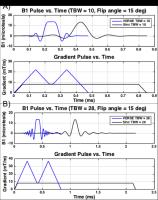 |
88 |
Design and Validation of a Minimum Time Verse Pulse for 4D Flow
MRI 
Patrick Magrath1,2, Eric Aliotta1,3,
Shams Rashid1, Yutaka Natsuaki4,
Xiaoming Bi4, Zhe Wang1,2, Kyung Sung1,2,3,
Peng Hu1,2,3, Holden Wu1,2,3, and
Daniel B Ennis1,2,3
1Department of Radiological Sciences, University
of California, Los Angeles, CA, United States, 2Department
of Bioengineering, University of California, Los Angeles,
CA, United States, 3Physics
and Biology in Medicine IDP, University of California, Los
Angeles, CA, United States, 4Siemens
Healthcare, Los Angeles, CA, United States
4D-flow MRI is used to quantify blood flow in a variety of
neurovascular pathologies including intracranial aneurysms
[1], but is limited by long scan times as well as moderate
spatial and temporal resolution. Conventional RF pulses have
poor slab profiles that contribute to low sequence
efficiency by increasing the field-of-view needed to avoid
aliasing in the slab direction. Our objectives were to
design a minimum time, high Time Bandwith Product (TBW)
VERSE pulse for 4D flow and to validate the improvement in
sequence efficiency, confirm flow accuracy, and evaluate
total SAR deposition for VERSE+4D-flow compared to our
clinical 4D flow imaging protocol.
|
|
2712.
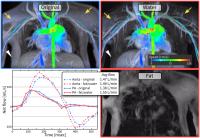 |
89 |
Contrast-Enhanced 4D Flow Imaging with Reduced Fat Signal 
Joseph Y. Cheng1, Tao Zhang1, Adam B.
Kerr2, Michael Lustig3, John M. Pauly2,
and Shreyas S. Vasanawala1
1Radiology, Stanford University, Stanford, CA,
United States, 2Electrical
Engineering, Stanford University, Stanford, CA, United
States, 3Electrical
Engineering & Computer Sciences, University of California,
Berkeley, CA, United States
Volumetric time-resolved velocity imaging (4D flow) can be
used as a single comprehensive sequence to quantify blood
flow, evaluate cardiac function, and assess anatomy.
However, fat signal can reduce tissue contrast, introduce
high-signal-intensity artifacts from motion, and cause
errors in velocity quantification. Two approaches are
presented for reducing fat signal in contrast-enhanced 4D
flow imaging with minimal time penalty. The first approach
is a short spectral-spatial RF pulse that reduces fat signal
below the level of contrast-enhanced blood pool. The second
approach is the introduction of one additional echo with a
different TE to separate fat/water for all flow encoding
echoes. The performance of these approaches are evaluated in
a static phantom study and in patient volunteer studies.
|
|
2713.
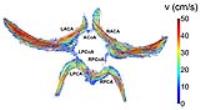 |
90 |
The Communicating Arteries Redistribute Blood Flow in the Circle
of Willis with Hypoplastic Segments: Intracranial 4D flow MRI at
7 Tesla 
Pim van Ooij1, Matthan Caan1, Bart M.
W. Cornelissen2, Henk A Marquering2,
Pieter Buur3, Gustav J Strijkers2,
Jeroen Hendrikse4, and Aart J Nederveen1
1Radiology, Academic Medical Center, Amsterdam,
Netherlands, 2Biomedical
Engineering & Physics, Academic Medical Center, Amsterdam,
Netherlands, 3Spinoza
Center for Neuroimaging, Amsterdam, Netherlands, 4Radiology,
University Medical Center Utrecht, Utrecht, Netherlands
In this study it was investigated if the communicating
arteries redistribute blood flow in the circle of Willis
(coW) with hypoplastic arteries. For this purpose, 4D flow
MRI at 7 Tesla was used in ten healthy volunteers. 50% of
the participants had a full coW, whereas 50% had hypoplastic
or missing segments. Significant correlations were found for
time-averaged blood flow (mL/s) between the left /right
posterior communicating artery and the left/right posterior
cerebral artery and between the anterior communicating
artery and the right anterior cerebral artery. This finding
illustrates that flow is redistributed through the
communicating arteries in the coW.
|
|
2714.
 |
91 |
Aortic hemodynamics in pediatric Marfan patients compared to
healthy pediatric subjects: heterogeneity in the Marfan
population 
Roel LF van der Palen1,2, Alex J Barker2,
Emilie Bollache2, Michael J Rose3, Pim
van Ooij4, Julio Garcia2, Luciana
Young5, Arno AW Roest1, Michael Markl2,6,
Cynthia K Rigsby3, and Joshua D Robinson5,7
1Department of Pediatric Cardiology,
Willem-Alexander Children and Youth Center, Leiden
University Medical Center, Leiden, Netherlands, 2Department
of Radiology, Feinberg School of Medicine, Northwestern
University, Chicago, IL, United States, 3Department
of Medical Imaging, Ann & Robert Lurie Children’s Hospital
of Chicago, Chicago, IL, United States, 4Department
of Radiology, Academic Medical Center, Amsterdam,
Netherlands, 5Division
of Pediatric Cardiology, Ann & Robert Lurie Children’s
Hospital of Chicago, Chicago, IL, United States, 6Department
of Biomedical Engineering, McCormick School of Engineering,
Northwestern University, Chicago, IL, United States, 7Department
of Pediatrics, Ann & Robert Lurie Children’s Hospital of
Chicago, Chicago, IL, United States
Marfan syndrome (MFS) is a connective tissue disease with
high risk of aortic dissection/rupture. Two-thirds of
dissections occur in the ascending aorta, one-third in the
descending aorta. Diameter plays an important role in risk
stratification. However, recent literature has shown
diameter only accounts for 50% of the dissections in the
descending aortic region. It is not well known how aortic
hemodynamics interact with the altered vascular structure of
these aortas and how it may impact dilatation. A cohort of
MFS children and an age appropriate control group were
evaluated with 4D flow MRI: already distinct abnormalities
are present in childhood.
|
|
2715.
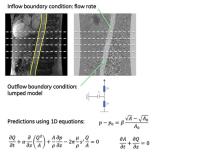 |
92 |
Model-based estimation of arterial pulse wave velocity from MRI
velocity data 
Prem Venugopal1, Ek Tsoon Tan1, Peter
Lamb1, Christopher J Hardy1, and
Thomas K Foo1
1GE Global Research, Niskayuna, NY, United States
Pulse wave velocity (PWV) is a commonly used surrogate for
arterial stiffness. This abstract describes a new method to
estimate arterial PWV by using MRI phase-contrast data to
tune a 1D blood flow model describing the hemodynamics and
propagation of the arterial pulse wave. Results obtained in
a single volunteer indicate that the proposed approach could
be used with low time resolution methods such as 4D Flow MRI
to obtain PWV in the aorta with much lower variability than
the foot-to-foot method.
|
|
2716.
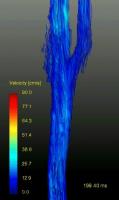 |
93 |
10 fold accelerated 4D flow in the carotid arteries at high
spatiotemporal resolution in 7 minutes using a novel 15 channel
coil 
Eva S. Peper1, Qinwei Zhang1, Bram F.
Coolen2, Wouter V. Potters1, Pim van
Ooij1, Dennis W.J. Klomp3, and Aart J.
Nederveen1
1Radiology, AMC, Amsterdam, Netherlands, 2Biomedical
Engineering and Physics, AMC, Amsterdam, Netherlands, 3Radiology,
UMCU, Utrecht, Netherlands
Using a novel 15 channel coil for carotid artery imaging we
could prove that the g-factor loss at higher acceleration
factors is limited. This permits the use of higher parallel
imaging factors than commonly exploited in carotid MRI. A 4D
flow scan at high spatiotemporal resolution was accelerated
10 fold (SENSE 4 x 2.5), resulting in high quality images
and consistent flow values acquired in a scantime as short
as 7 min.
|
|
2717.
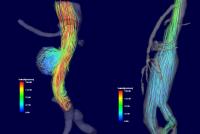 |
94 |
Lower Wall Shear Stress and Abnormal Hemodynamics within the
Saccular Aneurysm in Contrast to Fusiform Aneurysm in the
Abdominal Aorta. 
Masataka Sugiyama1, Yasuo Takehara2,
Hatsuko Nasu1, Shuhei Yamashita1, Mika
Kamiya1, Nobuko Yoshizawa1, Yuki Hirai1,
Takasuke Ushio1, Naoko Hyodo1, Yohei
Ito1, Naoki Oishi2, Marcus Alley3,
Tetsuya Wakayama4, and Harumi Sakahara1
1Radiology, Hamamatsu University School of
Medicine, Hamamatsu, Japan, 2Radiology,
Hamamatsu University Hospital, Hamamatsu, Japan, 3Department
of Radiology, Stanford University School of Medicine,
Stanford, CA, United States, 4Applied
Science Laboratory Asia Pacific, GE Healthcare Japan, Hino,
Japan
3D cine PC MRI (4D-flow) study of abdominal aorta was
conducted to measure wall shear stress (WSS) and to
characterize aortic blood flow dynamics within saccular and
fusiform abdominal aortic aneurysm and non-dilated aorta.
Peak systolic WSS was significantly lower within saccular
aneurysm, and stream line analysis depicted separated
vortex flow within the saccular aneurysm. The abnormal
vortex flow and consequent low WSS of saccular aneurysmal
wall may be reflecting the continuing risk of atherogenic
changes of the saccular aneurysm in contrast to fusiform
aneurysm.
|
|
2718.
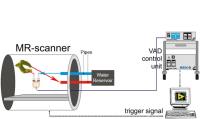 |
95 |
3D Printed Patient-Specific Model for In Vitro Hemodynamic
Studies and Comparison with In Vivo Findings Using 4D Flow MRI 
Rouzbeh R Ahmadian1, Austin P Boyd2,
Jeremy D Collins1, James C Carr1, Alex
J Barker1, and Michael Markl3
1Radiology, Northwestern University, Chicago, IL,
United States, 2Northwestern
University, Chicago, IL, United States, 3Radiology
& Biomedical Engineering, Northwestern University, Chicago,
IL, United States
The advent of 3D printing has opened exciting possibilities
for biomedical applications. One of the most intriguing of
these possibilities is the ability to use images obtained
from radiology scanners (CT or MR) to create 3D models of
patient anatomy followed by 3D printing. These models will
have all the same geometries of patient anatomy to very high
detail. In order to have practical applications, however,
these 3D models need to behave similarly to human tissue
under standard conditions. Our research utilizes
patient-specific 3D printed models in an in vitro fluid
dynamic circuit to compare 4D Flow MRI data to that of the
patient (in vivo). This direct comparison will allow for
validation of the 3D printed model for further biomedical
application.
|
|
2719.
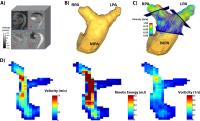 |
96 |
Volumetric assessment of kinetic energy and vorticity in the
pulmonary artery: alteration of flow hemodynamics in patients
with repaired tetralogy of Fallot using 4D flow MRI 
Julio Garcia1, Silvia Hidalgo Tobon2,3,
Guadalupe Sagaon Rojas4, Benito de Celis Alonso5,
Manuel Obregon2, Porfirio Ibanez2,
Julio Erdmenger6, and Pilar Dies-Suarez2
1Radiology, Northwestern University, Chicago, IL,
United States, 2Investigacion
en Imagen y Resonancia Magnetica Nuclear, Hospital Infantil
de Mexico Federico Gomez, Mexico City, Mexico, 3Physics,
Universidad Autonoma Metropolitana, Mexico, Mexico, 4Physics,
Universidad Autonoma Metropolitana, Mexico City, Mexico, 5Faculty
of Physics and Mathematics, Benemérita Universidad Autónoma
de Puebla, Puebla, Mexico, 6Pediatric
Cardiology, Hospital Infantil de Mexico Federico Gomez,
Mexico City, Mexico
Flow alterations in the pulmonary artery (PA) of patients
with repaired tetralogy of Fallot (rTOF) may be link with
elevated kinetic energy (KE). 4D flow MRI allows for the
non-invasive volumetric assessment of flow hemodynamics,
vorticity, and KE in patients with rTOF in the pulmonary
(PA). Thus, the aim was to investigate the impact of flow
alterations in the PA and its association with KE and
vorticity.
|
|
